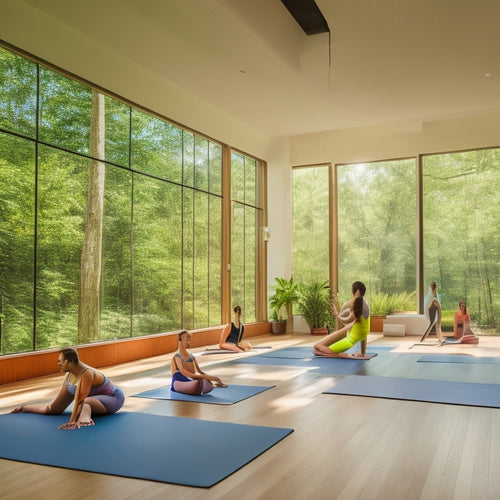
Streamline Your Creative Workflow: Artist's Productivity Hacks
Share
You're tired of creative blocks, wasted time, and missed deadlines. It's time to enhance your workflow! Start by prioritizing tasks using the Eisenhower Matrix, and allocate time strategically. Organize your digital workspace to boost mental clarity, and dedicate fixed blocks of time to tasks. Eliminate distractions, automate repetitive tasks, and set realistic deadlines. By streamlining your workflow, you'll access more time and energy for creativity. And, as you refine your workflow, you'll discover even more opportunities to optimize your creative process, maximize your productivity, and bring your artistic vision to life.
Key Takeaways
• Categorize tasks into must-do, should-do, and nice-to-do lists to prioritize and manage multiple projects efficiently.
• Organize computer files and desktop efficiently to reduce distractions and increase productivity.
• Allocate fixed, uninterrupted blocks of time to tasks and eliminate distractions during time blocks for focused work.
• Automate repetitive tasks to free up time and mental energy for creativity and high-priority tasks.
• Establish a consistent schedule and routine to regulate creative flow, boost productivity, and enhance artistic expression.
Mastering Task Prioritization Techniques
By categorizing tasks into must-do, should-do, and nice-to-do lists, you can strategically allocate your time and energy to maximize productivity. This prioritization technique is essential for creatives who juggle multiple projects and deadlines.
The Eisenhower Matrix, a powerful Priority Framework, helps you categorize tasks into four quadrants: urgent & important, important but not urgent, urgent but not important, and not urgent or important. This framework enables you to focus on high-priority tasks that drive meaningful progress.
Decluttering Your Digital Workspace
As you work on your latest project, you're likely juggling multiple files, apps, and tabs. Now's the time to take control of your digital chaos by organizing your computer files and tidying up your desktop.
Organize Computer Files
You're likely no stranger to the frustration of wasting valuable time searching for a specific file amidst a cluttered digital landscape. A disorganized digital workspace can stifle your creative flow and hinder productivity. It's time to take control of your computer files and streamline your workflow.
| Best Practices | Benefits |
|---|---|
| Use cloud storage | Access files from anywhere, collaborate easily |
| Create a clear file naming convention | Quickly identify files, reduce confusion |
| Set up folders and subfolders | Organize projects, reduce visual clutter |
| Use tags and labels | Easily search and categorize files |
| Regularly back up files | Protect against data loss, ensure business continuity |
Tidy Up Desktop
With your computer files now organized, it's time to focus on the digital real estate that matters most: your desktop, where a cluttered landscape can lead to mental fatigue and decreased productivity.
A tidy desktop is essential for a clear mind and efficient workflow. Think of it as a digital canvas, where every icon and folder has its designated place.
Start by grouping similar files and folders together, and assign them a designated zone on your desktop. Use folders with clear labels, and avoid generic names like 'Misc' or 'Stuff.' This will help you quickly locate what you need, reducing the time spent searching for files.
Consider implementing a desktop decor that inspires creativity, such as a motivational quote or a beautiful image.
Finally, practice good icon organization by categorizing your apps and files into folders, and keep your most-used items front and center.
Time-Blocking for Maximum Focus
By dedicating fixed, uninterrupted blocks of time to specific tasks, you can harness the power of time-blocking to maximize your focus and productivity. This technique allows you to allocate specific time slots for tasks, eliminating distractions and minimizing multitasking.
With time-blocking, you can schedule Creative Sprints – intense, focused periods of work – followed by regular breaks to recharge. This approach helps you stay committed to your goals and make significant progress on your projects.
To get started, identify your most important tasks and allocate Focus Windows – dedicated time slots for each task. Be realistic about how long each task will take, and leave some buffer time for unexpected interruptions.
As you work within these time blocks, eliminate distractions by turning off notifications, finding a quiet workspace, or using website blockers. By doing so, you'll be able to tap into your creative potential, stay motivated, and achieve a sense of accomplishment.
Customizing Your Workflow Systems
Your workflow system is a dynamic, ever-evolving framework that requires periodic fine-tuning to stay aligned with your creative vision and goals.
As you navigate the twists and turns of your artistic journey, your workflow system must adapt to accommodate new projects, collaborations, and deadlines.
To optimize your workflow, try color-coding your tasks, categorizing them by priority, project, or deadline. This visual system helps you quickly identify patterns, relationships, and areas for improvement.
Another essential tool is workflow mapping, which involves diagramming your workflow to identify bottlenecks, inefficiencies, and opportunities for streamlining. By mapping your workflow, you'll uncover hidden patterns, simplify complex processes, and eliminate unnecessary steps.
By customizing your workflow system, you'll be able to respond to changing circumstances, capitalize on new opportunities, and ultimately, create more efficiently and effectively.
Eliminating Distractions and Procrastination
As you work on your artistic projects, you know that staying focused is key to achieving your vision.
But let's face it, distractions and procrastination are constant threats to your productivity.
To overcome these obstacles, you need to develop strategies to minimize digital noise and set realistic deadlines that keep you on track.
Minimize Digital Noise
Developing strategies to quiet digital distractions that lurk around every corner, constantly threatening to derail your creative momentum is essential for maintaining focus.
You know the drill – notifications, emails, and social media notifications can be overwhelming, making it difficult to concentrate on your craft.
To minimize digital noise, consider a digital detox. Set aside specific times to check your phone or computer, and stick to those times. This will help you avoid mindless scrolling and reduce the temptation to procrastinate.
You can also implement social silence, where you take a break from social media or limit your online presence. This will help you avoid distractions and comparisons that can stifle your creativity.
Set Realistic Deadlines
To ensure effective project management, it's crucial to set realistic deadlines that foster accountability, helping you maintain focus and prevent procrastination. This strategy enables you to break down extensive projects into smaller, more manageable tasks, reducing feelings of being overwhelmed.
Establishing practical timelines increases the likelihood of consistent progress, subsequently alleviating Deadline Anxiety. However, incorporating Flexibility Planning into your schedule is vital to address unforeseen obstacles or creative hurdles that may arise. This practice allows you to steer clear of the constraints of rigid schedules while retaining a sense of command over the project's development.
Keep in mind that realistic deadlines should be ambitious yet reachable, encouraging efficient work without unnecessary stress. Embracing this methodology will cultivate a sense of achievement and drive, motivating you to deliver your finest work.
Streamlining Your File Organization
You can drastically reduce the time spent searching for files by establishing a consistent naming convention and folder structure. This simple habit can save you hours of frustration and allow you to focus on what matters most - creating.
Here are three essential tips to help you streamline your file organization:
-
Use Cloud Storage: Consider utilizing cloud-based services like Google Drive, Dropbox, or OneDrive to store and access your files from anywhere. This will also guarantee that your files are backed up and protected from data loss.
-
Create a Folder Hierarchy: Set up a clear folder structure with clear labels and categories. This will help you quickly locate files and avoid duplicates.
-
Implement Folder Archiving: Set up an archiving system for completed projects, allowing you to easily access and reference past work.
Automating Repetitive Tasks Efficiently
As an artist, streamlining repetitive tasks is essential to gaining more time for creative pursuits, and there are several tools and strategies that can help you do just that. By automating tasks, you can free up time and mental energy for more important things - like creating! Task automation is a key part of workflow optimization, and it's easier than you think.
Here are a few examples of tasks you can automate, and some tools to help you do it:
| Task | Tool | Benefit |
|---|---|---|
| Resizing images for social media | Adobe Photoshop | Saves 30 minutes/day |
| Organizing files by project | Google Drive | Reduces file search time by 75% |
| Sending follow-up emails | Mailchimp | Increases response rate by 25% |
Setting Realistic Creative Deadlines
With your workflow optimized and repetitive tasks automated, it's time to turn your attention to setting realistic creative deadlines that align with your artistic vision and goals. This is essential to avoiding deadline anxiety and ensuring your creative scope remains manageable.
To set realistic deadlines, consider the following:
-
Break down large projects into smaller tasks: Divide your project into smaller, manageable tasks to estimate the time required for each task accurately.
-
Pad your deadlines: Add a 10-20% buffer to your estimated completion time to account for unexpected setbacks or creative blocks.
-
Leave room for iteration: Allow time for revisions and feedback to guarantee your final product meets your artistic standards.
Maintaining a Consistent Schedule
Establishing a consistent schedule is crucial for regulating your creative flow, ensuring that inspiration strikes when you need it most. By committing to a daily routine, you'll find that your mind becomes more receptive to new ideas and insights.
It's vital to create a schedule that works for you, not against you. Start by identifying your most productive hours and allocate them to your most critical tasks. Then, break down larger projects into manageable chunks, and assign specific tasks to specific times of the day.
To maintain daily accountability, set reminders, and track your progress. This will help you stay focused and motivated, even on days when inspiration seems elusive.
By incorporating creative routines into your daily schedule, you'll find that your artistic expression becomes more consistent and refined. Remember, consistency breeds creativity, and with a well-planned schedule, you'll be amazed at how your productivity and artistic growth soar.
Frequently Asked Questions
How Do I Handle Creative Blocks and Stay Motivated During Long Projects?
When creative blocks hit, you shift gears with mindful warmups to loosen up your thinking, then ignite your flow with focused creative sprints, breaking through barriers and reigniting your passion.
Can I Use These Productivity Hacks for Non-Visual Creative Work, Like Writing?
You can absolutely apply these hacks to non-visual creative work like writing. By implementing content planning and consistent writing routines, you'll stay focused, avoid burnout, and make steady progress on your writing projects.
Are There Any Specific Workflow Systems for Collaborative Projects?
When collaborating, you'll thrive with systems like Asana or Trello, which enable clear Project Roles and Task Delegation, ensuring each team member knows their responsibilities and deadlines, facilitating seamless workflow and minimizing confusion.
How Do I Balance Creative Freedom With the Need for Structure and Routine?
You establish a delicate balance between creative freedom and structure by implementing flexible frameworks that provide a sense of security, while creative guardrails guarantee that your artistic vision stays on track, allowing you to thrive within a defined scope.
Are These Productivity Hacks Suitable for Beginners With Limited Experience?
"Rome wasn't built in a day," and neither is mastering productivity hacks. As a beginner, you'll face a learning curve, but don't let a skill gap intimidate you - start small, be patient, and adapt these hacks to fit your unique creative flow.
Related Posts
-

Jazz Dance Makeup Tutorials for Dazzling On-Stage Looks
To achieve a dazzling on-stage look for your jazz dance performance, you'll want to focus on mastering stage makeup e...
-

Essential Spandex Shorts for Yoga and Pilates
Essential spandex shorts are vital for your yoga and Pilates practice. Look for moisture-wicking technology to keep y...
-

Instant Download Card for Dance Recital Performances
Instant download cards are a convenient way to commemorate dance recital performances, providing a seamless solution ...


